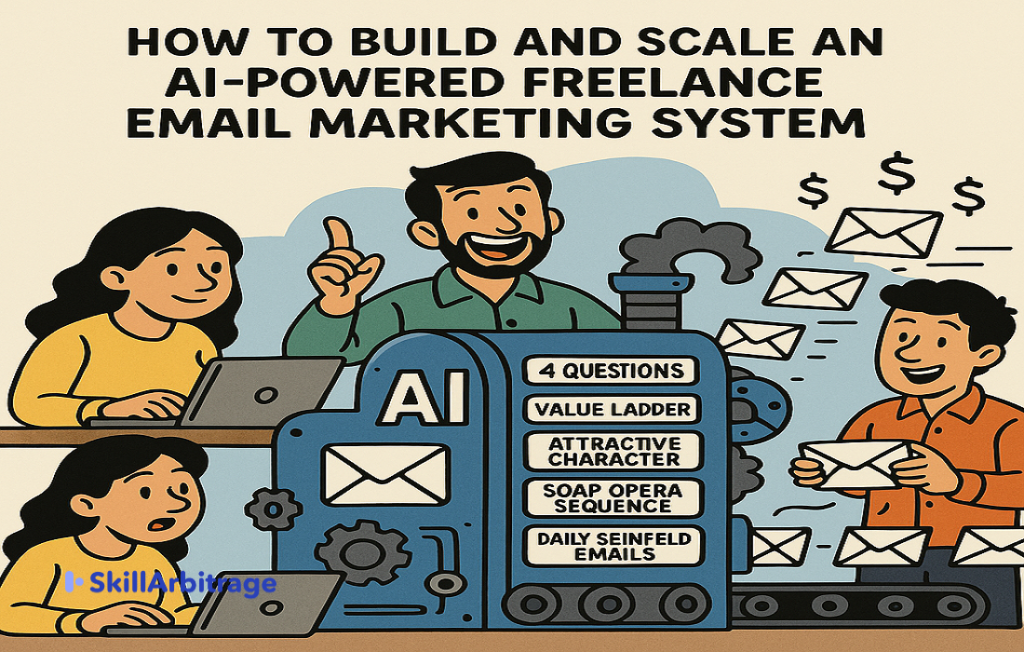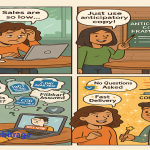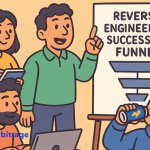This article teaches how to build and scale an AI-powered email marketing system quickly and efficiently. You’ll learn how to automate customer insights, craft a multi-tiered offer stack, develop a brand voice, and generate daily content, all using AI tools to create a fast, scalable email engine that drives revenue.
Table of Contents
Previously in Seinfeld Emails
In the previous article, Harsh showed Swathi how to craft engaging Seinfeld emails. In this article, the trio takes it a step further by building a complete AI-powered email system, automating everything from customer insights to daily content, making it faster and more scalable than ever.
The café buzzed with the nervous energy of a team that had just landed their dream client and was now completely out of their depth.
Savitha couldn’t stop refreshing the email.
Raja hadn’t touched his filter coffee.
Harsh was pacing, his phone still warm from the call.
“Their founder loves the plan,” he finally said. “Wants the whole system. Four questions. Value ladder. Attractive character. Soap opera. Daily emails. All of it.”
He paused.
“They want it live in seven days.”
Silence.
Savitha stared. “You mean the same sequence that takes us 3 weeks?”
“They don’t care. They said, and I quote, ‘You’ve already done this once. Just do it faster.’”
The client wasn’t some slow-moving corporate. It was BareMode, a fast-growing barefoot shoe brand run by an ex-military, now mountain-climbing, startup-slaying maniac named Neel Marathe. He’d built the company on brutal product speed and founder-led storytelling. His motto? Launch fast, sell loud, fix later.
Neel didn’t want polished. He wanted velocity.
Raja let out a long breath. “We pitched a Ferrari. They want it delivered like pizza.”
This wasn’t just a dream project. It was a trapdoor gig. Say yes, and you’re suddenly freefalling through expectations no normal freelancer could meet. But say no, and the window closes. Forever.
Harsh finally sat down. “We asked for this. We pitched the whole damn system. And now they want the goods.”
Savitha pulled out her laptop. “Then we build it like a system. No more artisan writing. We modularize, templatize, and AI the hell out of this.”
Raja cracked a grin. “We don’t write the funnel. We manufacture it.”
The rush was real. The tension high. BareMode had given them the green light but if they couldn’t move faster than any freelancer shop in the game, it’d be gone just as fast.
Your inbox is a goldmine, if you know how to dig
They moved to a corner table. The coffee shop was loud, but their conversation had tunneled into that focused hum. Half panic, half thrill.
Raja pulled out a notebook, trying to sketch the entire funnel from memory.
Savitha was already in a Notion doc, tagging past campaigns they could reuse.
Harsh had opened six browser tabs and one ChatGPT window.
But thirty minutes in, they weren’t much closer to a plan.
Every email idea felt like juggling flaming pins:
You needed customer insights to know what to say.
You needed a funnel plan to know where to say it.
You needed a strong voice to say it like a human, not a brochure.
You needed a narrative sequence to onboard them.
And you needed daily stories to keep the list alive and buying.
Most freelancers write emails like they’re writing their personal diary, when they feel like it, how they feel like it, for whatever random offer’s lying around. Manual. One-off. Slow.
But Harsh had been studying Brunson. And he knew the real game was already solved.
Brunson wasn’t writing emails anymore. He was running a system.
Each framework stacked on the last. 4 Questions, Value Ladder, Attractive Character, Soap Opera, Seinfeld.
Not separate ideas. One machine.
All connected. All monetizable. All fast.
Harsh leaned across the table.
“Guys. We’re not just freelancers writing emails. We’re system builders. We just need AI to act like the engine room.”
That was the moment the panic broke. The trapdoor closed.
They weren’t falling anymore. They had a floor to stand on.
5 building blocks
Raja took a slow sip of his coffee. “Okay. Let’s say we do this. Let’s say we use AI. What are we even asking it to build?”
Harsh grinned. “An engine.”
He looked at the others. “And every engine has parts. Ours has five.”
He raised one finger.
“4 Questions: That’s how we find out who we’re talking to, where they hang out, what bait they’ll bite, and what result they crave.”
Another.
“Value Ladder: That’s how we turn one small job into a revenue ladder. One email is the entry point. The rest pull them up the slope.”
A third.
“Attractive Character: That’s how we give the brand a voice. Not a newsletter robot. A real person with quirks, flaws, and punchlines.”
Fourth.
“Soap Opera Sequence: That’s how we turn cold leads into loyal fans. One story arc, five cliffhanger emails.”
Fifth.
“Daily Seinfeld Emails: That’s how we sell every day, without sounding salesy. A personal story. A link. A sale.”
Savitha nodded slowly. “So these five are the whole email system.”
“Exactly,” Harsh said. “Now let’s build an AI-powered engine that runs all five on autopilot.”
Step 1: Build your customer intel using ChatGPT (4 Questions)
The coffee cups were empty. The adrenaline wasn’t.
Savitha opened her laptop and tapped the table. “We can’t guess what these barefoot people care about. We need real voice-of-customer stuff.”
Harsh nodded. “Start with intel. Always.”
Raja leaned over. “How fast can we get it?”
Harsh pulled up ChatGPT. “Watch.”
He typed:
“Act like a market researcher. Based on this [client website], who is their dream customer? Where do they hang out online? What kind of free bait would they click on? What results do they crave?”
In seconds, ChatGPT responded like it had read ten years of customer support tickets and subreddit threads.
Who is the ideal customer?
Trail runners who care more about foot strength than shoe style. Yoga moms who don’t trust mainstream brands. Digital nomads who want to feel the ground in Bali and Bangalore.
Where do they hang out?
Reddit threads on foot pain. Podcasts on primal movement. Minimalist forums. Instagram pages on earthing and functional fitness.
What bait would work?
Free foot-strengthening PDFs. Barefoot challenge email series. “Find your barefoot type” quizzes.
What results should we promise?
Better posture. Fewer injuries. More energy. That grounded, primal confidence that comes from walking like nature intended.
“Holy hell,” Raja said. “This would’ve taken me a week.”
Harsh smirked. “Save it all into Notion. Call it our ‘Persona & Positioning Sheet.’ This is our copy compass now.”
Swathi’s brand voice, the product’s promise, and the audience’s language all starting to lock into place.
The race was on.
Step 2: Map a simple offer stack (Value Ladder)
They barely had time to breathe. The client had approved the first draft of personas. Now came the harder part. Turning those insights into money.
Raja stared at the screen. “One product isn’t enough. We need an offer stack. Something that pulls people in and moves them up.”
Savitha glanced at the barefoot shoe homepage. “They’re selling a ₹6,000 pair of shoes. What’s the ₹600 entry? What’s the ₹60,000 future?”
Harsh was already typing:
“Based on this client’s product, write a simple Value Ladder from entry offer to high-ticket service.”
ChatGPT responded:
- Low-ticket: “21-Day Barefoot Challenge” for ₹199. Email course + printable tracker.
- Core offer: Premium barefoot shoes, ₹6,000. Flagship product.
- High-ticket: 1-on-1 foot mobility consult + training plan, ₹25,000. For athletes, biohackers, or those recovering from injury.
Raja whistled. “We just turned one product into three tiers of revenue.”
Harsh scribbled into his notebook.
Email goal for the low-ticket offer? Build trust and get them in the ecosystem.
Core offer? Tell stories that make the product inevitable.
High-ticket? Offer it as a natural next step for the serious few.
Savitha nodded. “So every email now has a job. A direction. We’re not just talking. We’re moving people.”
The engine was beginning to hum.
Step 3: Build the attractive character sheet
They had the customer. They had the ladder. But the emails still felt… dead.
“Something’s off,” Savitha said, narrowing her eyes. “Reads like AI wrote it for a TED Talk.”
Harsh didn’t argue. He already knew the problem. “We’re missing Neel. The brand is Neel. And this? This isn’t him.”
Raja pulled up a podcast where Neel was mid-rant about bloated shoe tech. “He said, ‘People are strapping trampolines to their feet and wondering why their knees hurt. Just walk barefoot, man.’”
Harsh grinned. “There it is.”
He fed ChatGPT three sources: a brutally honest founder’s update from BareMode’s Substack, a caption where Neel called insoles “foam diapers for your feet,” and a tweet storm where he challenged Allbirds to a hike with no shoes.
The prompt was simple:
Analyze the tone and personality from these 3 sources. What’s the founder’s voice? Write a short brand bio in their style.
ChatGPT came back:
- Voice: Blunt, kinetic, no-BS
- Pet peeves: Cushion addiction, slow brands, fake nature
- Beliefs: The body adapts fast. Speed is a weapon. Shoes should feel like skin.
- Humor: Military-dry. Sometimes rude. Always earned.
Savitha opened a new doc titled “Neel’s Voice Bible.”
“This is our script,” she said. “Every email. Seinfeld, Soap Opera. All of it runs through this.”
Raja nodded. “We’re not ghostwriting anymore. We’re channeling the guy.”
The next email didn’t sound like copy.
It sounded like Neel, kicking in the door barefoot.
Step 4: Generate the Soap Opera Sequence
The voice was locked in. BareMode finally had blood in its emails.
Now they needed to bring people into that world. Not with specs. Not with discounts. With story.
“We need a 5-day sequence,” Harsh said, “that makes you feel like you’re buying a mission, not a shoe.”
Savitha sipped her filter coffee. “Like a soap opera,” she said. “Get them hooked. Drag them through the mud. Then give them a way out.”
Raja already had the prompt open:
Write a 5-part email sequence that introduces Neel Marathe and leads to the core product. Make it emotional and story-driven.
ChatGPT returned the structure:
- Hook: “The Day I Couldn’t Walk”
- Backstory: “From Infantry Boots to Barefoot”
- Epiphany: “Your Body Isn’t Broken, Your Shoes Are”
- Struggle: “Fighting Pain, Doctors, and Dumb Ads”
- Invitation to Act: “Join the Barefoot Rebellion”
Harsh read it aloud. It didn’t feel like marketing. It felt like Neel himself storming your inbox, telling you why comfort was killing you.
Savitha started formatting the emails.
Raja just smiled. “Now we’ve got them. One foot in the inbox. One foot on the trail.”
And the path forward was clear.
Step 5: Spin daily Seinfeld Emails from life
The soap opera sequence was set. But Neel wasn’t the type to stop at a five-day drip.
“He wants daily,” Raja said. “That’s his style. Loud. Fast. Constant.”
Savitha winced. “Thirty emails a month? We’ll die.”
Harsh grinned. “Not if we feed the machine.”
He opened a new doc. At the top, he typed:
Dropped protein bar in gym urinal
Forgot left shoe at a campsite
Argued with cabbie about arch support
Watched a guy run barefoot in a suit
Had to explain barefoot shoes to my mom (again)
“These aren’t just stories,” he said. “They’re ammo.”
He plugged one in:
Write a daily email in the Seinfeld style. Use this story: [Watched a guy run barefoot in a suit]. Tie it back to a barefoot shoe offer.
ChatGPT turned it into a punchy, 200-word story. Funny opener, sharp turn, soft pitch. Done.
They ran five prompts in a row. Got a week of content. No fluff. All voice.
Savitha nodded. “Now we’re talking.”
Raja leaned back. “Emails used to feel like work. Now it’s just spotting weird moments and letting AI punch it up.”
And just like that, BareMode had a living, breathing inbox engine, fed by real life, tuned to the founder’s voice, always pointing back to the sale.
In 48 hours, they had it all.
Customer insights on tap.
Offers mapped like a funnel sniper.
Brand voice bottled.
Founder’s story set to auto-play.
Daily content spinning off real life like magic.
No blank pages. No second-guessing. No slow starts.
Raja looked around the café table. “You realize what we’ve built, right?”
Harsh nodded. “A founder-led, high-conversion email machine that runs on AI and five real strategies.”
Savitha smiled. “And now any freelancer can offer this. Daily monetization, baked into a brand’s voice, delivered at the speed of business.”
Neel didn’t want cute. He didn’t want corporate. He wanted results, fast. They gave him a weapon.
Now it’s your turn.
Build this for one brand, and you’re a freelancer.
Build this for three, and you’re an email consultant with monthly retainers.
Build this for yourself, and you’ve got an inbox that prints money.
The strategy is real. The AI is ready. The only question is…
Who are you building this engine for?







 Allow notifications
Allow notifications
